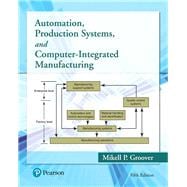For advanced undergraduate/graduate-level courses in Automation, Production Systems, and Computer-Integrated Manufacturing.
Provides the most up-to-date coverage of automated production systems
Automation, Production Systems, and Computer-Integrated Manufacturing provides up-to-date coverage of production systems, how they are sometimes automated and computerized, and how they can be mathematically analyzed to obtain performance metrics. The text is designed primarily for engineering students at the advanced undergraduate or beginning graduate levels in industrial, mechanical, and manufacturing engineering. The book is also useful for practicing engineers and managers who wish to learn about automation and production systems technologies in modern manufacturing.
This exploration of the technical and engineering aspects of automated production systems provides the most advanced, comprehensive, and balanced coverage of the subject of any text on the market. It covers all the major cutting-edge technologies of production automation and material handling, and how these technologies are used to construct modern manufacturing systems. The 5th Edition has consolidated and reorganized many of the topics, eliminated material that is no longer relevant, and revised end-of-chapter problems.










